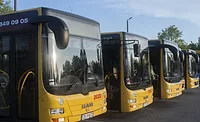Denver RTD Bolsters Bus Safety with Mobile Video Solution
The Denver Regional Transportation District (RTD) operates almost 1,000 buses, traveling over 100,000 miles and serving an average of 330,000 passengers each day. To help keep passengers and operators safe, RTD transit police rely on mobile video cameras installed on its fleet of buses. Video is a vital tool for investigating incidents – accidents, falls, ADA complaints, bad behavior on the part of passengers or employees, and even crime.
Unfortunately, RTD’s older analog video system often failed. Even when the cameras were working, poor quality video made it difficult to reliably identify people or understand what really happened. The cameras also recorded to a digital video recorder (DVR) on the bus. This meant that a transit police officer would have to drive to the bus depot and pull the DVR hard drive to physically retrieve video when it was needed for an investigation.
“We recently had an incident occur on a bus at five o’clock on a Friday afternoon,” explained Bob Grado, RTD Transit Police Commander and Manager of Integrated Security Operations. “Someone had to stay on overtime, drive through rush hour traffic to get to the bus, pull the hard drive, and come all the way back to do the review. It took four to five hours round trip, and the hard drive had failed anyway, so there was no video.”
Grado felt something needed to be done. He wanted a high-quality digital video system that would download video wirelessly off the bus, so investigators could access it without leaving their desks. Grado knew that RTD was planning to replace its fleet of buses, so he recommended a simultaneous mobile video technology upgrade. RTD had already experienced success using the NiceVision video surveillance software for its Park-n-Ride facilities, light rail, and bus transfer stations, so Grado proposed leveraging that same proven technology for RTD’s mobile environment.
But there were some challenges.
“Mobile is a very different environment from a fixed location,” acknowledged Grado. “It has to support GPS coordinates, so we know where an incident took place, and it has to be rugged, reliable, and easy to service.” The biggest issue was finding a way to download the video wirelessly.
RTD invited several companies, including NICE Systems, to participate in a test. “We simulated a bus pulling in and out of a depot by putting video servers on dollies and moving them in and out of the WiFi network to see if they could automatically connect and start downloading,” explained Grado.
Fast-forward to today, and RTD is in the process of implementing NICE’s mobile video solution on its fleet. The software runs on hardware from Panasonic Corporation of North America’s Transit Solutions group, including specialty cameras and a mobile recording platform specially designed to withstand vibration and weather extremes.
Over the next three years, RTD hopes to retrofit approximately 500 buses with the mobile video solution, which will allow video to be downloaded automatically via WiFi whenever a bus pulls into a depot, passenger concourse, or RTD facility.
The new system also gives RTD transit police investigators high definition video, which was not available before. RTD redesigned the camera layouts, and the new system can support up to nine cameras, so more of the bus is covered.
But the biggest benefit, according to Grado, is the ability to access the video remotely through the NICE Inform solution. “We no longer have to go to the depot and remove the hard drive,” he explained. “Right from our desks, we just type in the bus number, date, and the time range for the video we need. When the bus connects with WiFi, the system checks with the server to see if any video has been requested. If so, it immediately starts the download process.”
Grado is excited about being able to use this platform to integrate mobile video and audio from its buses with other incident records. “Let’s say an incident started on a bus, but the person involved then went into a station,” explains Grado. “With NICE Inform we can incorporate the bus video, the audio, the fixed video from the station, the phone conversations with transit police, and even radio communications between the command center and the field. It can all be compiled into a complete timeline so an investigator can see how the incident played out.”
In addition, the new mobile video system enhances RTD’s ability to share video and collaborate with other law enforcement agencies. With the old system, it took up to two days to collect the video, and an officer from the collaborating agency had to come to the RTD location to retrieve it. With the new system, the video and other supporting information is compiled easily, and RTD can email a link to the case file to other law enforcement agencies involved in the investigation.
Looking for a reprint of this article?
From high-res PDFs to custom plaques, order your copy today!







